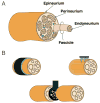The Evolution of Neuroprosthetic Interfaces
- PMID: 27652455
- PMCID: PMC5541680
- DOI: 10.1615/CritRevBiomedEng.2016017198
The Evolution of Neuroprosthetic Interfaces
Abstract
The ideal neuroprosthetic interface permits high-quality neural recording and stimulation of the nervous system while reliably providing clinical benefits over chronic periods. Although current technologies have made notable strides in this direction, significant improvements must be made to better achieve these design goals and satisfy clinical needs. This article provides an overview of the state of neuroprosthetic interfaces, starting with the design and placement of these interfaces before exploring the stimulation and recording platforms yielded from contemporary research. Finally, we outline emerging research trends in an effort to explore the potential next generation of neuroprosthetic interfaces.
Figures





References
-
- Thurston AJ. Paré and prosthetics: the early history of artificial limbs. ANZ J Surg. 2007;77(12):1114–9. - PubMed
-
- Grill WM, Norman SE, Bellamkonda RV. Implanted neural interfaces: biochallenges and engineered solutions. Annu Rev Biomed Eng. 2009;11:1–24. - PubMed
-
- Fetz EE. Operant conditioning of cortical unit activity. Science (80-) 1969 Feb 28;163(3870):955–8. - PubMed
Publication types
MeSH terms
Grants and funding
LinkOut - more resources
Full Text Sources
Other Literature Sources

